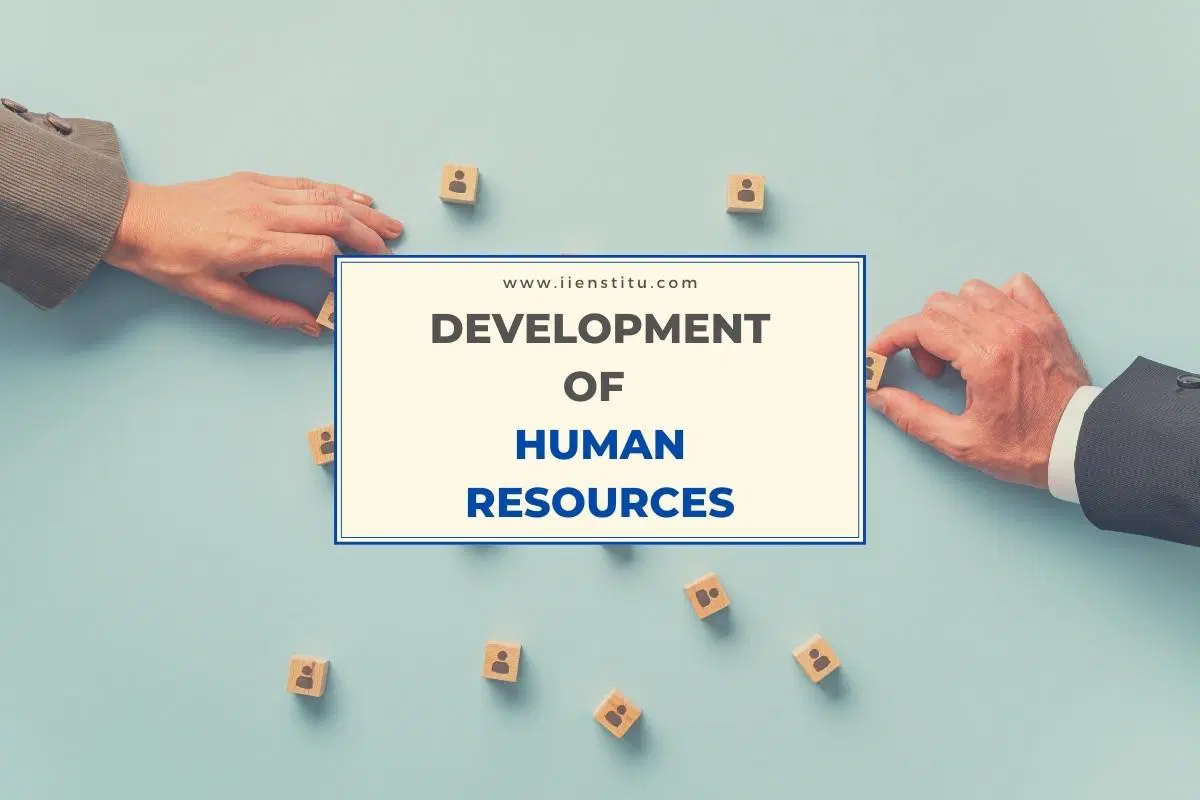
In this day and age the human resources department is a main focal point of any companies business plan. Human resources can make or break a company's success. A strong, trustworthy, productive workforce can lead to profit increases for the company therefore giving them more power in terms of gaining consumer confidence which will eventually lead to increased Market share.
This means that the management must be very careful when hiring individuals who are employed by their organization. Today legal action can take place if they discriminate against certain groups of people. These groups include race, gender, gender identity, religion, disability status etc… This all falls under what is called anti-discrimination laws created by Title VII of the Civil Rights Act 1964 .
The original was to prevent employers from treating employees differently based on their religion, sex, or national origin. Title VII has been expanded by later legislation such as The Equal Opportunity Act 1984 and with the Civil Rights Act of 1991 which now prohibits discrimination due to race, color, religion, sex ,or national origin.
Now is it only illegal for employers to discriminate against their employees but also illegal for them not to hire someone under certain circumstances. That includes one needing a work permit and is over the age of 16 (in most states) and can prove they are a legal citizen of this country through providing identification like a social security card or birth certificate. This prevents any companies from hiring individuals who do not meet those guidelines set forth by federal law that all businesses must follow.
How is Human Resource Management Related to Business?
Related Course: Hr Online Course
The role of human resource management in the corporate world is one that has been thrust into the spotlight recently, with many arguing that it is no longer an optional practice for businesses to consider. Instead, there are some who believe that it must be considered beyond a luxury and become an expected part of doing business; if only for financial reasons.
As far back as 2001, research showed that companies which did not provide decent packages of benefits were losing out to their competitors by around 3 percent of gross revenue. That may not seem like much but when you calculate how many more clients or customers they could gain from this difference over the course of a year, suddenly the numbers get pretty substantial. A few years later ( 2006) another piece of research was carried out and it concluded that companies which failed to manage their employees effectively were losing as much as 13.5 percent of their gross revenue; this is over 22 times the amount companies who invested in human resource management lost.
This has led many people to conclude that it is no longer a worthwhile idea for business owners to rely on the workers you already have as opposed to recruiting new workers; even if they need specific skills or experience. If you do not address human resource management now, chances are your competitors will and before long, they will take all your customers away from you and leave you with an empty stock room and high levels of debt. This means learning how to invest in creating strategies for managing your workforce so that you can benefit from this huge competitive advantage over your competitors.
In terms of products, companies can sell what they have but there are things that human resource management can offer which are unique to the business world. This is not something you can get from any other kind of organisation so it stands to reason that you should do everything in your power to protect this asset for as long as possible. As well as offering strategies for recruiting and retaining staff, it also offers advice on how to go about rewarding employees who perform exceptionally well.
There are many theories regarding why people work - some believe that it is all down to payment while others believe that motivation comes from a number of different places. There are even studies which seem to indicate that makes little difference when it comes to the satisfaction of a worker. They will be happy if they have certain things in their life which can include anything from being able to provide for a family to having enough free time.
Another benefit is that you can monitor the performance of your employees and get rid of those who are not up to scratch. On average, this process takes around six months but there are some cases where it can take as much as eighteen months or even longer depending on the circumstances. However, if you do not dispose of these workers properly then there is a risk that they will spread toxic behaviour within the rest of your workforce which could bring down productivity in an instant. It would be much cheaper for you to make sure that these individuals leave on good terms instead, especially since it is likely they may work in the same industry in future.
So how can you effectively manage your workforce? The simplest way is to set out a strategy for hiring new workers that you believe will be beneficial to your company. This could include individuals who have worked for your competitors in the past and using the money saved on wages to offer higher wages than anyone else is currently offering. When it comes to retaining staff, one of the best things you can do with help from human resource management is offer attractive bonuses or incentive packages which are aimed at keeping them working hard until retirement age; when they collect their pension pot.
Another key part of human resource management deals with employee development as this helps build loyalty within an organisation as well as allowing skilled employees to pass on their knowledge and expertise to newer members of staff. This strengthens the overall structure and offers a much better chance for growth which is why many businesses now use this method as opposed to simply punishing poor performers.
As you can see, it is advisable to be kinder to your workforce as this will increase their productivity; at least in the short-term. Over time though, they will make more errors because they don't feel like putting in as much effort as they used to whether there is a reward attached or not. It might not always make sense but investing in human resource management does work, even if it takes time before you start seeing results.
What Does Human Resource Management Mean for Employees?
When we think of the concept of human resource management, we often envision a robust and well-oiled company. There will be no hitches in operations and all employees know exactly what to do.
This might appear very idealistic, but it's actually possible for HR professionals to create such an environment within their company, especially if everyone pitches in together. For example, there are ways that you can promote employee satisfaction by keeping them pleased with their jobs , compensation they receive once they've completed their work tasks , career development opportunities , as well as flexibility on how they go about doing things . The idea is that your team members should feel like they own the business they're working for so everything falls under their.
Aside from that, not only should you keep in mind the well-being of your employees, but also their safety. Once again, it's best to ask for volunteers when it comes to risky work tasks. This way, there will be no injuries or accidents at all because everyone will have given their consent ahead of time.
What Is the Historical Development of Human Resource Management?
The HRM system has changed a lot throughout history. Let's consider the historical process together;
Early Human Resource Management (HRM): 1861 – 1990s
Before the 19th century, workers were treated as subservient to employers and their needs were ignored by organizations. However, with the increase in worker's awareness, there was a need for organizations to create systems appropriate for managing employees' concerns; this lead to the development of HRM. The origins of modern day human resource management can be traced back to Frederick Taylor who introduced scientific management and Henry Ford who created Volvo and initiated the moving assembly line which revolutionized how things were done and became part of everyday life.
Early developments at the end of the 19th century
The early years saw a few changes in regard to hiring and employee selection. Organizations' main concern during this time was efficiency; selection became a means to recruit employees capable of completing tasks efficiently and meeting required standards. Companies were looking for ways to make their businesses more profitable and efficient by using scientific notions such as meritocracy which gave rise to psychological testing as a way for organizations to select those who would fit within company culture and achieve individual goals.
In the 1920s, the focus of recruitment shifted from efficiency to a more people-centered approach which was introduced by Elton Mayo. This new outlook led to a rise in employee satisfaction and increased productivity. In addition, during this time job analysis became common practice as it allowed companies to determine the specifications for jobs hence making them easier to fill. The primary concern at this point was meritocracy which continued into the 1950s.
"The 1960s brought about significant changes in personnel management through government intervention and regulation" . Employees' concerns came under consideration at this time due to the introduction of equal employment opportunities and affirmative action which allowed the disabled, women and minorities to be integrated into work places. It is during this time that organizations recognized benefits such as training programs that would improve their employees' skills and knowledge in order for them to remain relevant.
1970s – The influence of psychoanalytical theories
The 1970s saw a shift from a systems approach focusing on a multidimensional structure to a more individualistic perspective known as self-fulfillment theory. This new emphasis on improving an employee's quality of life resulted in the birth of human relations movement. Despite the fact that many organizations failed to implement these changes it served as an eye opener for others who were quick to embrace the concept of "people as the organization's most important resource". In addition to this, organizations implemented psychoanalytical theories as a way to evaluate their employees' needs and determine what organizational changes needed to be made.
The 1980s – An even more people-centered approach
During this time, organizations shifted from focusing on the individual employee to emphasizing teamwork which resulted in an increase in productivity and efficiency. This was also a turning point because it marked the beginning of HRM becoming increasingly concerned with strategic planning that would improve employees' involvement within work environment. The 80s also saw job enlarg emerge as a benefit offered by companies in order to attract and retain employees.
The 1990s – The start of global HRM
"This decade was highly influential in changing the focus of human resource management from just an organizational approach towards showing concern for the entire workforce". Organizations started to see beyond their own borders when developing policies, programs and benefits making them people-centered. With the integration of nationalities came an increase in multiculturalism which led to changes in regard to hiring practices. For example, organizations had to look at employee diversity in regards to gender, race and ethnicity in order to ensure there was no discrimination within work places. Work performance also became a major component when measuring employees' effectiveness; this was evident in the introduction of the balanced scorecard concept. This allowed organizations to determine if their goals were properly aligned with their organization's core values.
The 2000s – The fundamental shift towards employee involvement and participation
This decade marked a fundamental shift in HRM when it comes to employees' involvement within different activities that would improve work environment thus creating an open culture of trust that is vital for success. At this point employees are encouraged to speak up about any concerns they may have while management structure is adapted to fit today's needs. Organizations also recognized the importance of collective bargaining agreements which led to stronger relations between employers and employees resulting in better business decisions being made by both parties. These relationships are also supported by initiatives that have been implemented through different governments around the world which work to improve working conditions and ensure fair treatment of employees.
The future – A worldwide focus on social responsibility
With today's global community employers are facing new challenges in regard to how they manage their workforce due to globalization. Organizations see great value in investing in education, training, technology as well as providing benefits for their employees. According to recent findings "with organizations looking beyond their own borders it is evident that human resource management will continue evolving into a more collaborative approach". This means that organizations will start collaborating with local communities which will give them an opportunity to see first hand how they can support the economy while still maintaining high standards for all of their employees.
The future of HRM is still in the early stages and there is no telling how it will look like in a few years from now. With that being said, one thing remains certain – human resource management will continue to evolve as it has been doing for many years. In order to be successful organizations will need to keep up with the ever changing activities that occur within this industry. This means that they need to stay connected through various social networks and ensure they are engaging in meaningful conversations with their target audience. As sure as day follows night there needs to be a constant flow of information between employees and companies which would mean more work on the employers' end but a better understanding of what employees want and expect from them.
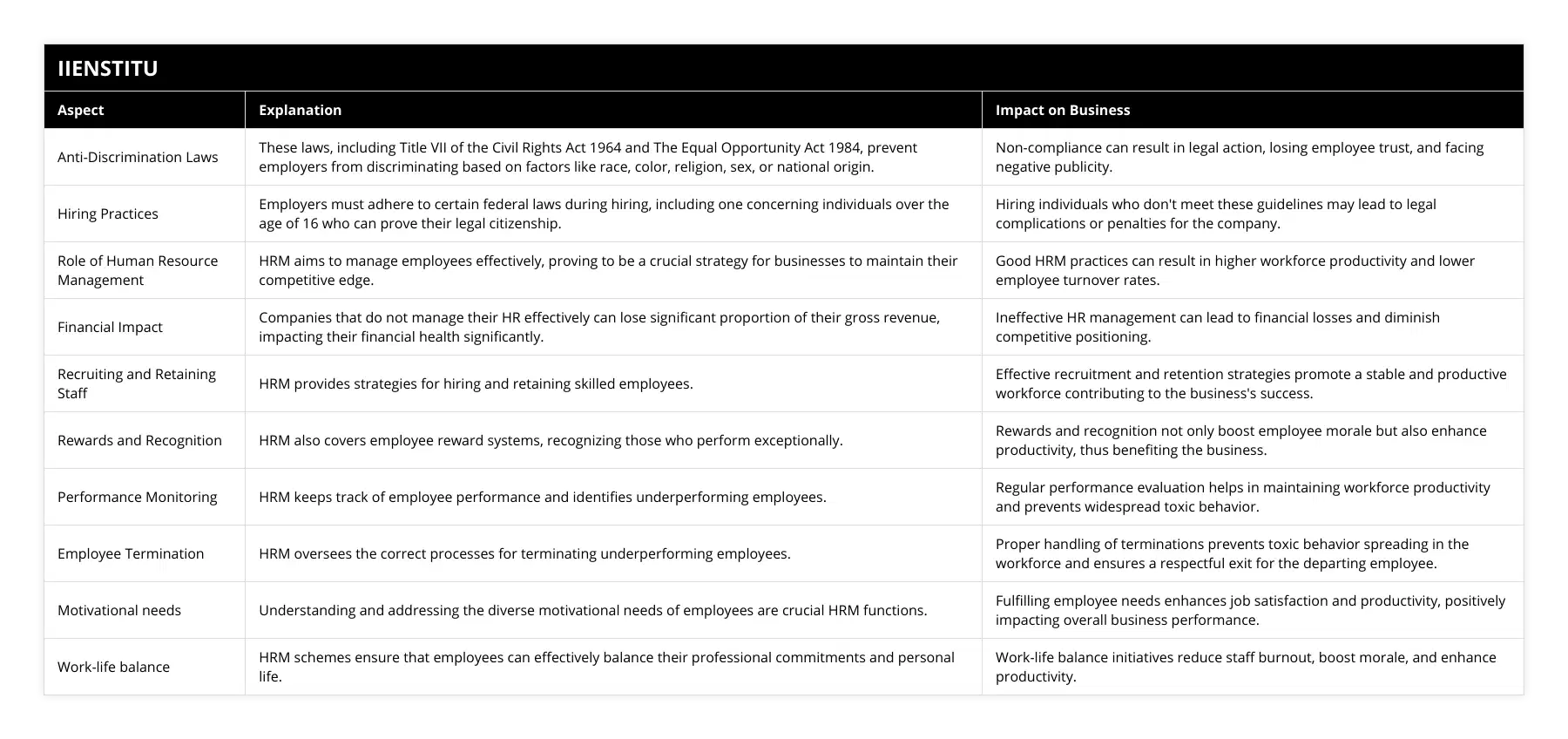
Frequently Asked Questions
How is human resource management related to business?
The HRM is the most important departman to work life. This departman related to workers and their development on company.
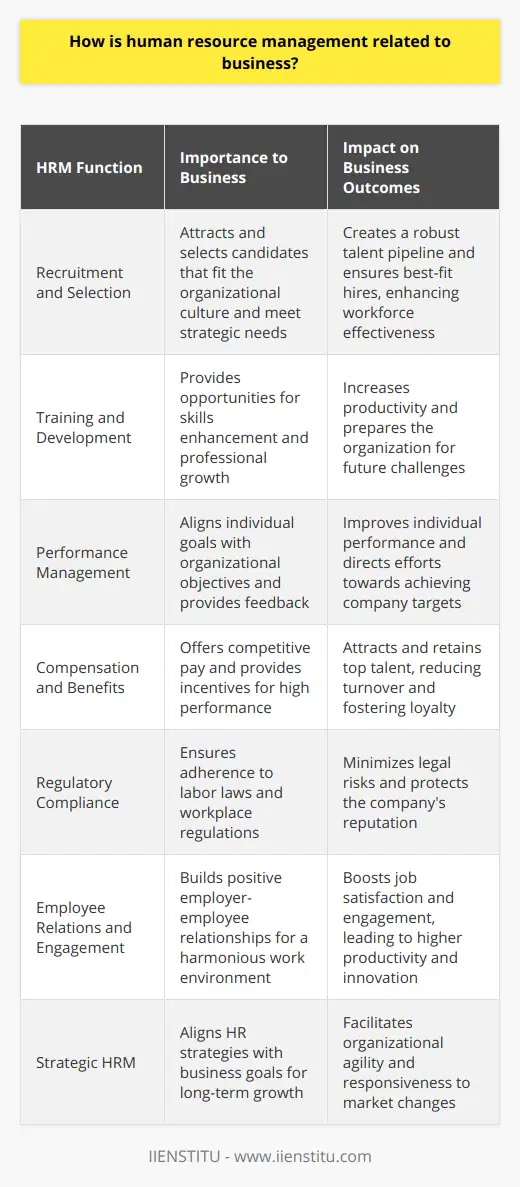
What does human resource management mean for employees?
This means growth and success in their career life. Job security is provided to worker.
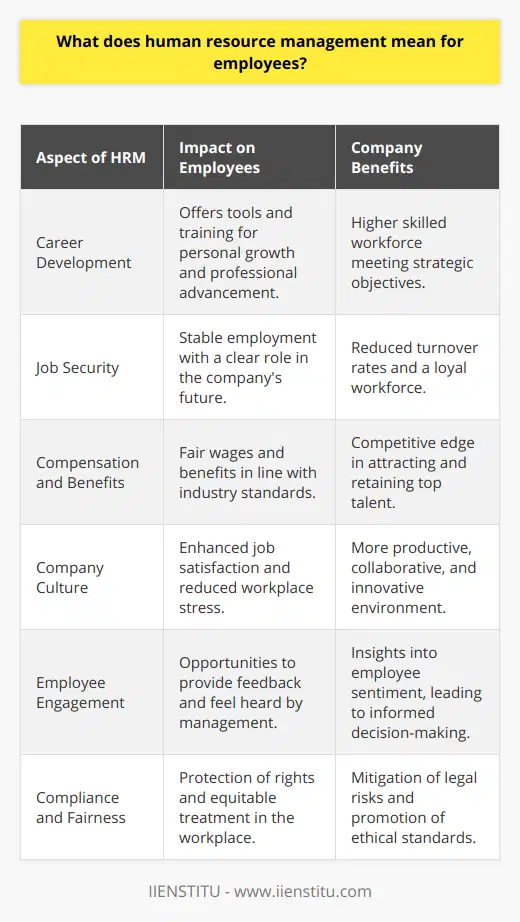
What is the development of human resources?
Human resources began to develop by the 18th century and has become todays. So many development factors appeared in history.
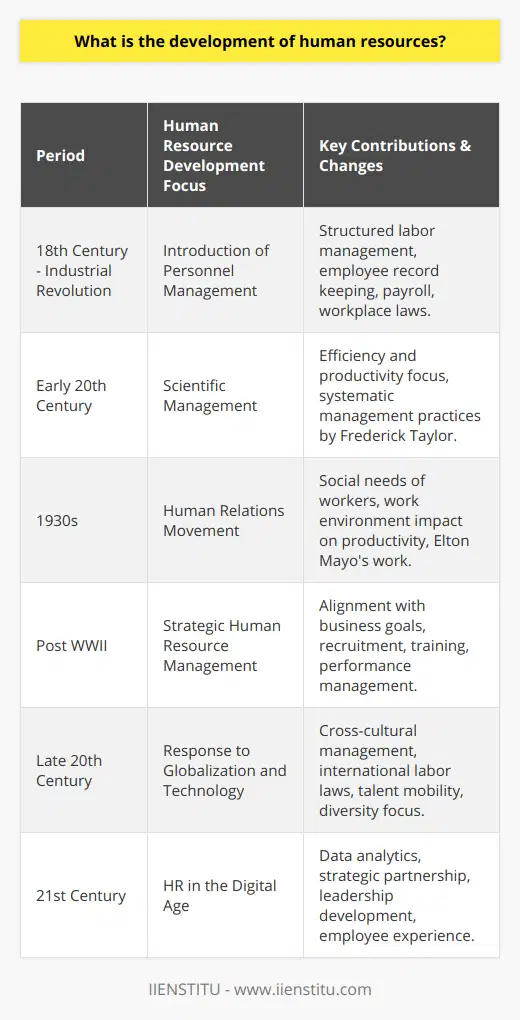
What factors influence the effectiveness of human resource development?
Factors Influencing HRD Effectiveness
The effectiveness of human resource development (HRD) is shaped by various factors that contribute to its overall success. These factors can be categorized into organizational context, employee characteristics, and the quality of HRD interventions.
Organizational Context
The organizational culture, structure, and strategy play a significant role in determining HRD effectiveness. An organization with a strong learning culture will likely prioritize employee development and provide a supportive environment for growth. Additionally, organizations with clear strategic objectives related to talent management and employee development can align HRD efforts to deliver on their goals.
Employee Characteristics
Individual factors such as the employee's motivation, learning style, and ability to adapt to change can impact the success of HRD interventions. Highly motivated employees with growth mindsets are more likely to engage fully in learning and development activities. Furthermore, a workforce with diverse learning styles will require HRD professionals to customize their interventions to cater to those differences, ensuring maximum effectiveness.
Quality of HRD Interventions
The effectiveness of HRD interventions is largely dependent on their design, delivery, and evaluation. High-quality interventions are based on a thorough needs assessment, employ sound instructional design principles, and facilitate the transfer of learning to the workplace. Additionally, the use of relevant technology and embracing innovative learning solutions can enhance the reach and impact of HRD interventions.
Moreover, regular evaluation of HRD effectiveness is essential to ensure that the interventions are aligned with organizational goals and adaptable to the changing needs of the workforce. By assessing the outcomes and return on investment of HRD initiatives, organizations can make informed decisions on future talent development efforts and ensure their continued success.
In conclusion, the effectiveness of human resource development is influenced by a combination of organizational context, employee characteristics, and the quality of HRD interventions. By addressing these factors, organizations can create a more productive and engaged workforce that is equipped with the necessary skills to succeed in the ever-changing business landscape.
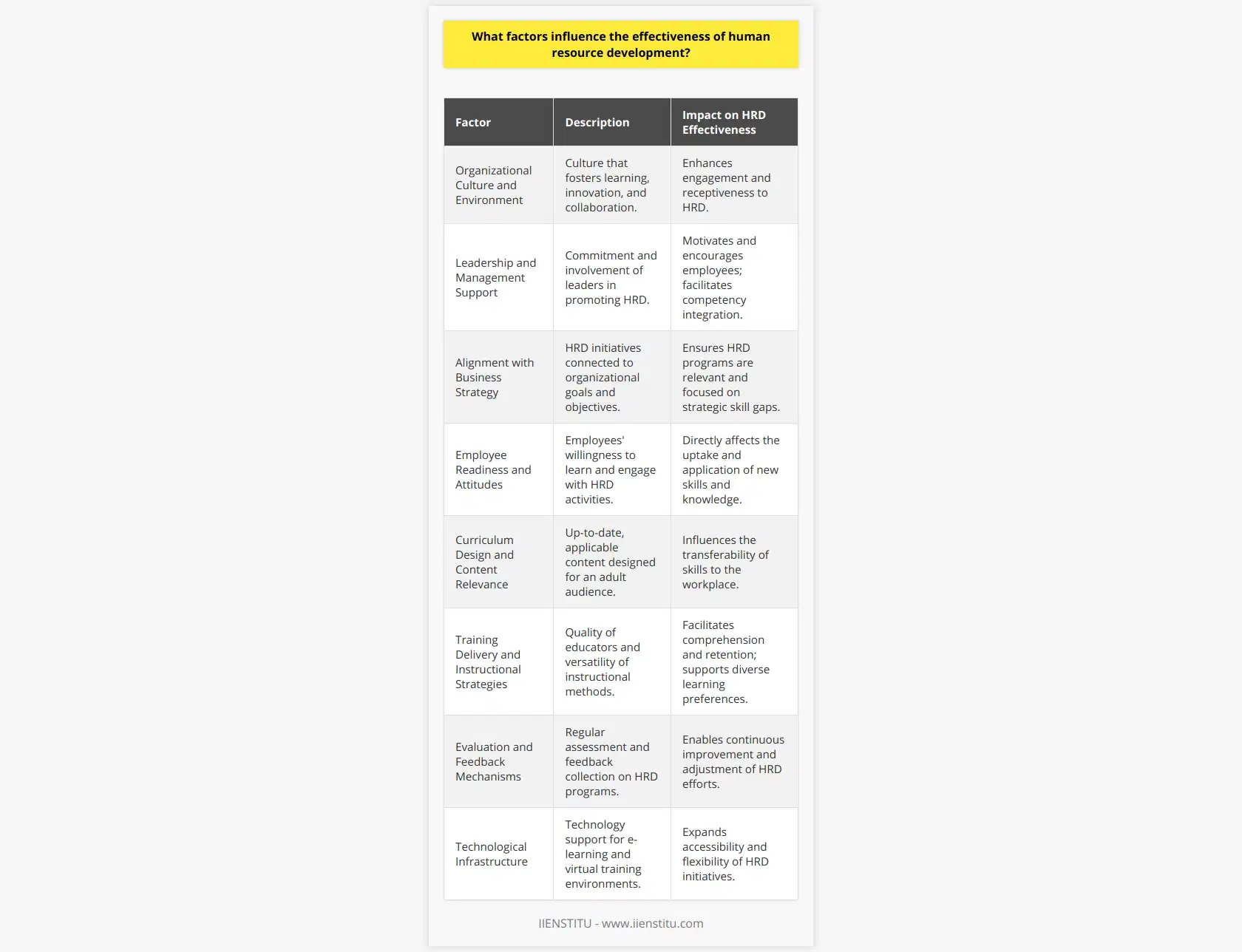
How do organizational culture and structure impact human resource development?
Organizational Culture and Its Effects on HR Development
Organizational culture significantly impacts human resource development by shaping the values, beliefs, and norms that drive employee behavior. When an organization fosters a culture that encourages learning and development, employees are more likely to engage in professional growth opportunities, improve their skill sets, and enhance their job performance.
Effect of Organizational Structure on HR Development
The structure of an organization, referring to the way the organization arranges its departments or teams, also influences HR development. A flat organizational structure, characterized by fewer levels of hierarchy and increased autonomy for employees, can positively impact HR development by allowing employees to be more involved in decision-making processes and giving them opportunities to take on leadership roles. On the other hand, a hierarchical organizational structure may inhibit HR development due to higher levels of bureaucracy and fewer opportunities for employee input or initiative.
Role of Communication in HR Development
Effective communication channels are essential components for a healthy organizational culture and structure. Open and transparent communication facilitates the exchange of ideas and knowledge, which ultimately contributes to employee's professional growth and development. When employees have access to clear communication channels, they can obtain valuable feedback, learn from their colleagues' experiences, and actively participate in organizational changes and improvement initiatives.
Encouraging Adaptive Learning and Development
Organizations that promote a culture of continuous learning and development recognize the importance of staying relevant in their industries. These organizations not only provide necessary resources for employee training but also encourage adaptive learning. By fostering a culture that accepts and embraces change, employees are more likely to stay motivated, enhance their skills in response to evolving business needs, and stay competitive within their respective markets.
Striking Balance Between Autonomy and Accountability
Organizational culture and structure should support a balance between employee autonomy and accountability. When organizations enable employees to make decisions and take ownership of their work, they foster a sense of responsibility and encourage continuous improvement. At the same time, clear expectations and support systems should be in place to ensure that employees understand their roles and responsibilities, thereby increasing the chances of successful HR development outcomes.
In conclusion, an organization's culture and structure immensely impact human resource development. When these elements are designed to promote learning, open communication, adaptive growth, and a balance between autonomy and accountability, organizations can boost employee engagement, satisfaction, and overall performance.

What role does technology play in the advancement of human resource development?
Role of Technology in Human Resource Development
Enhancing Training and Development
Technology plays a crucial role in the advancement of human resource development by facilitating effective training and development programs. Through e-learning platforms and online courses, employees can acquire new skills and knowledge at their own pace, without the constraints of time and location.
Improving Recruitment and Selection
The use of technology in recruitment and selection processes allows organizations to streamline their hiring process and find the best talent. Applicant tracking systems, social media advertising, and virtual interviews are examples of technological tools that help HR professionals reach a broader candidate pool and make data-driven decisions regarding potential hires.
Increasing Employee Engagement
Technology can also significantly impact employee engagement, which is vital for overall productivity and employee retention. Digital tools like collaboration platforms and instant messaging software make it easier for employees to communicate, share ideas, and collaborate on projects, fostering a sense of unity and engagement within the organization.
Automating Routine Tasks
Automation of routine tasks is another area where technology significantly contributes to human resource development. By using software for payroll processing, benefits management, and performance review, HR professionals can focus on more strategic tasks like talent management, workforce planning, and employee development initiatives. This shift in focus leads to more efficient use of resources and improved human resource development practices.
Supporting Data-Driven Decision Making
Finally, technology enables HR professionals to harness the power of data and analytics for better decision-making. Data analytics software can identify patterns and trends related to employee performance, turnover, and recruitment, allowing HR practitioners to make informed decisions that align with organizational goals.
In conclusion, technology plays an integral role in advancing human resource development by enhancing training and development, improving recruitment and selection, increasing employee engagement, automating routine tasks, and supporting data-driven decision-making. As organizations continue to embrace technology, HR practices will experience significant improvements, ultimately leading to the development of more effective and productive workforces.
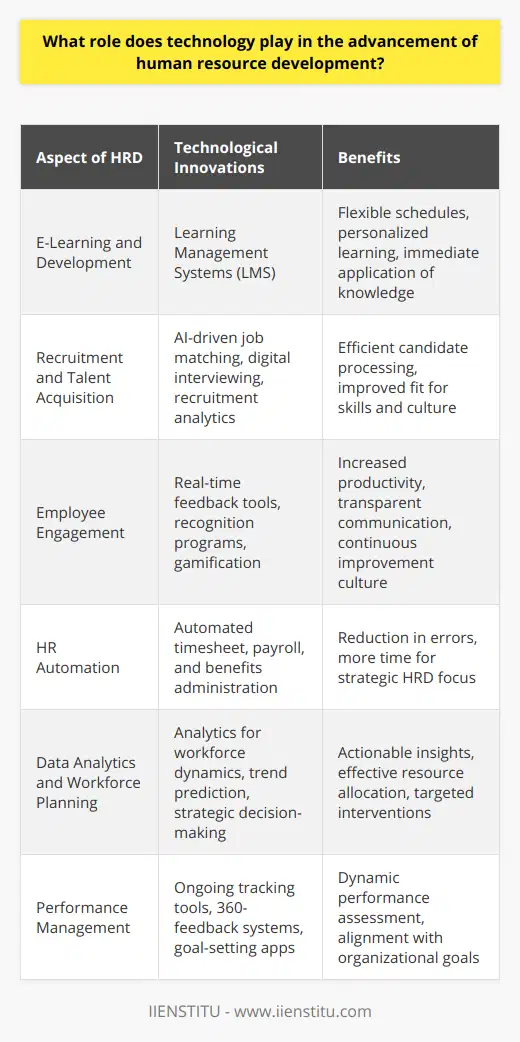
What is human resource development with example?
Understanding Human Resource Development
Human resource development (HRD) is a broad organizational process that focuses on enhancing individual, group, and organizational capabilities to enhance overall performance. There are several approaches and tools utilized within this framework.
Employee Training and Development
One key aspect of HRD is employee training and development, which ensures that an organization's workforce remains up-to-date with the latest industry trends, technologies, and best practices. For instance, a company that wants to increase its sales performance may offer specialized training programs for its sales representatives to improve their communication, negotiation, and presentation skills.
Capacity Building
Another important dimension of HRD is capacity building, which aims at fortifying an organization's abilities to effectively address current and future challenges. For example, a firm might invest in enhancing its technological infrastructure by implementing a robust data management system to streamline work processes and support decision-making.
Talent Management
Talent management is another crucial aspect of HRD, involving acquiring, nurturing, and retaining skilled and motivated individuals. By offering competitive compensation packages, supportive work environments, and clear career progression paths, organizations can attract and retain top talent. For instance, a technology company might create a comprehensive employee development program that includes mentorship, career coaching, and opportunities for training and further education.
Organizational Culture
A thriving organizational culture is also integral to HRD, as it creates a supportive work environment that fosters collaboration, learning, and innovation. A strong culture nurtures an atmosphere in which employees feel valued, engaged, and empowered to take risks and contribute their best efforts. This can be exemplified by Google's well-known corporate culture that encourages creativity, collaboration, and innovative thinking.
Leadership Development
Leadership development is another essential component of HRD, as effective leaders inspire others to achieve their potential and contribute to organizational success. For example, a business might offer leadership training courses or coaching for managers to strengthen their decision-making, communication, and interpersonal skills, empowering them to guide their teams and drive organizational growth.
In conclusion, human resource development plays a critical role in ensuring an organization's long-term success by focusing on enhancing individual, group, and overall performance. Through employee training, capacity building, talent management, cultivating a thriving organizational culture, and leadership development, organizations can create an engaged, skilled, and motivated workforce, ready to navigate the challenges of the ever-evolving business landscape.
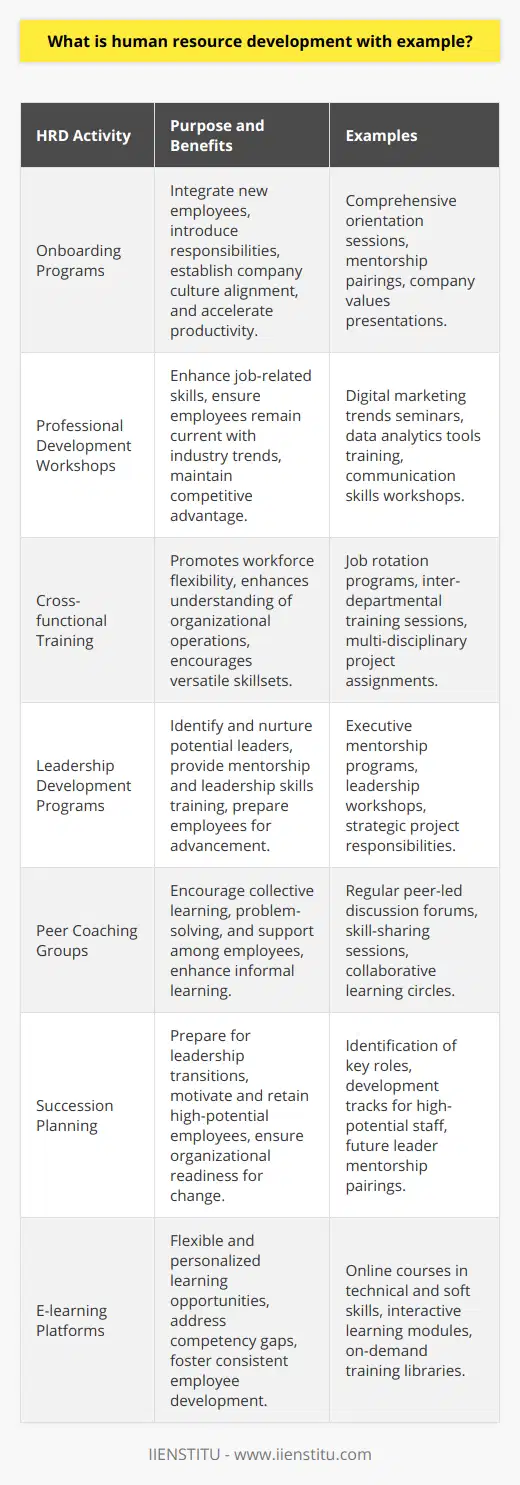
What led to the development of human resources?
Evolution of Human Resource Management
The development of human resources can be traced back to several factors that contributed to the evolution and recognition of the field. Initially, the need to address labor-related issues and manage employees surfaced during the Industrial Revolution, when rapid industrialization led to complex workforce challenges. The demand for increased production and efficiency necessitated the introduction of scientific management, spearheaded by Frederick Taylor, which focused on workflow analysis and employee specialization.
Role of Unions and Labor Relations
In addition to industrialization, the formation of labor unions played a crucial role in shaping human resources. Labor unions advocated for employee rights, working conditions, and compensation. Their growing influence led to the emergence of labor relations as an essential component of managing human resources. Companies began to establish dedicated departments to handle employee grievances, negotiate contracts, and enforce labor laws, thereby setting the groundwork for modern-day human resources management.
Psycho-Social Aspects and Work-Life Balance
Another essential factor in the development of human resources was the recognition of the psychological and social aspects of the workplace. The Hawthorne Studies, conducted in the 1920s and 1930s, demonstrated that employee productivity and satisfaction were closely tied to factors such as interpersonal relationships and job security. As a result, human resources started to incorporate motivational theories, communication strategies, and employee engagement programs. Additionally, the introduction of work-life balance initiatives, flexible working hours, and family-friendly policies further expanded the scope of human resources.
Legal and Regulatory Influences
Moreover, the enactment of critical employment legislation significantly impacted human resources development. Laws related to equal employment opportunity, fair labor standards, occupational safety, and health protection made it increasingly essential for organizations to manage their workforce adhering to such regulations. Consequently, the role of human resources transformed from merely addressing employee grievances to ensuring compliance with various labor laws and creating an equitable work environment.
Globalization and Technological Advancements
Globalization and advancements in information technology have profoundly influenced the development of human resources as well. The availability of talents across borders and the ability to manage employees remotely required human resources to adopt more sophisticated tools and strategies to address diverse workforce needs effectively. Additionally, technological advancements, such as the proliferation of HRIS (Human Resource Information Systems), have facilitated more streamlined and efficient human resources processes.
In conclusion, the development of human resources emerged from a multitude of factors, including the Industrial Revolution, labor relations, psycho-social studies, legal enactments, globalization, and technology. While the field continues to evolve, its core objective remains to optimize workforce management and enhance employee productivity and satisfaction.
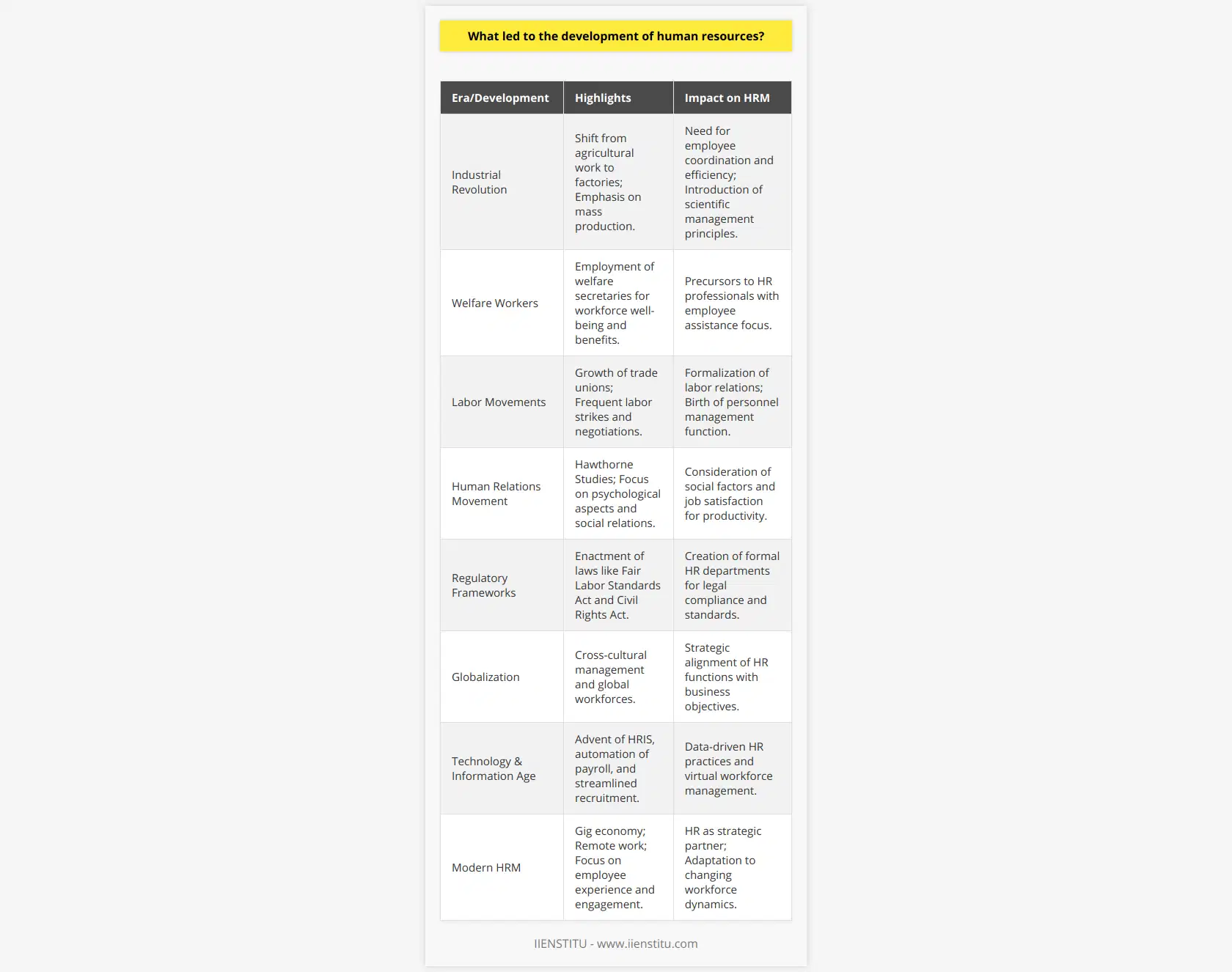
What are the stages of human resources development?
Stages of Human Resources Development
Identifying Organizational Needs
The first stage in human resources development is identifying organizational needs. This requires assessing the company's strategic goals and evaluating the current workforce's capabilities to achieve those goals. The human resources department must collect and analyze data to identify specific knowledge, skills, and abilities required for each role within the organization.
Recruitment and Selection
Recruitment and selection form the second stage, wherein the HR department seeks out candidates with the necessary knowledge, skills, and abilities. This process involves creating job postings, sourcing applicants through various channels, and screening resumes. The selection process includes conducting interviews and assessments to ensure that candidates are a good fit for the organization in terms of technical abilities and cultural alignment.
Training and Development
The third stage involves developing the competencies of employees through training and development programs. HR professionals must design and implement relevant training courses that focus on enhancing employees' skillsets and knowledge. This may encompass internal training sessions, external workshops, or online courses, depending on the specific requirements of the organization and the employees.
Performance Appraisal
Next comes the performance appraisal, which plays a vital role in human resources development. HR professionals must evaluate employees' performance, based on predefined goals and objectives. This assessment allows for identifying employees' strengths and weaknesses, aligning their progress with organizational expectations, and providing constructive feedback for improvement.
Career Planning and Development
In the fifth stage, HR professionals help employees in their career planning and development. This involves identifying employees' career aspirations, determining how those aspirations align with organizational goals, and offering guidance and support to help employees reach their desired career milestones. HR professionals may provide employees with the resources needed for continued growth, such as educational opportunities, mentorship programs, or exposure to diverse experiences and projects.
Succession Planning
Lastly, the process of succession planning aims to ensure the long-term sustainability and success of the organization. HR professionals need to identify high-potential employees who could potentially take on leadership roles in the future. This involves assessing employees' performance, potential, and readiness for advancement, as well as providing targeted development opportunities to help prepare them for more significant responsibilities within the organization.
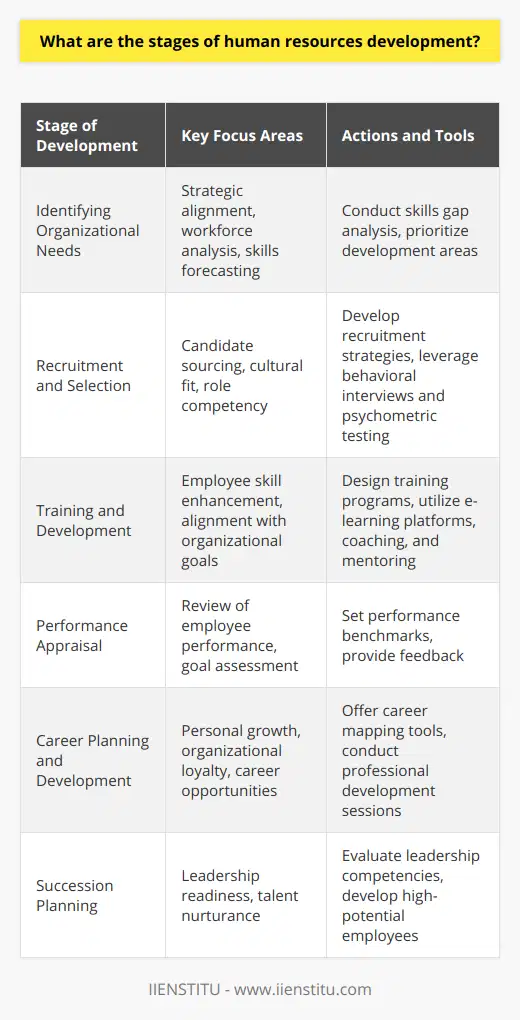
What is human resource development and its importance?
Understanding Human Resource Development
Human resource development (HRD) is a critical process for organizations to improve their employees' skills, abilities, and knowledge. This process encompasses various activities and practices designed to foster learning, personal growth, and increased productivity among the workforce. HRD aims to develop individuals, teams, and the organization as a whole to create an environment where employees can perform at the highest possible level.
Significance of HRD in Organizational Success
HRD is essential for organizations for several reasons. Firstly, the experience and knowledge of a company's workforce directly affect its competitive advantage. Developing employees' talents and skills ensures that organizations can adapt to changing market conditions and remain successful in a dynamic environment.
Promotion of Employee Engagement and Retention
Moreover, HRD plays a vital role in fostering employee engagement and retention. Providing learning opportunities and promoting personal growth contribute to employees feeling valued and motivated. Engaged employees are likely to be more productive, demonstrate higher levels of commitment, and remain loyal to the organization.
Enhancing Workplace Agility and Adaptability
HRD also contributes to organizational agility and adaptability. Continuous training and development of workforce skills help an organization to efficiently respond to new challenges, such as technological advancements, global competition, and changes to industry regulations. Developing employees' abilities to navigate and adapt to uncertainty prepares companies to face potential disruptions and maintain resilience.
Facilitating Improved Performance and Productivity
The foundation of HRD is the ability to drive performance improvements and productivity enhancements. By investing in employee development, organizations can optimize their workforce's proficiency, resulting in better-aligned competencies and career aspirations with organizational objectives. Developing employees allows an organization to close skill gaps, improve processes, and capitalize on human capital effectively.
In conclusion, human resource development is a critical aspect of managing an organization's workforce. By investing in HRD, organizations can improve employee skills, recognize and develop employees' potential, and enhance their overall engagement and motivation. Ultimately, HRD enables organizations to maintain a competitive advantage, adapt to changing market conditions, and foster growth and success.
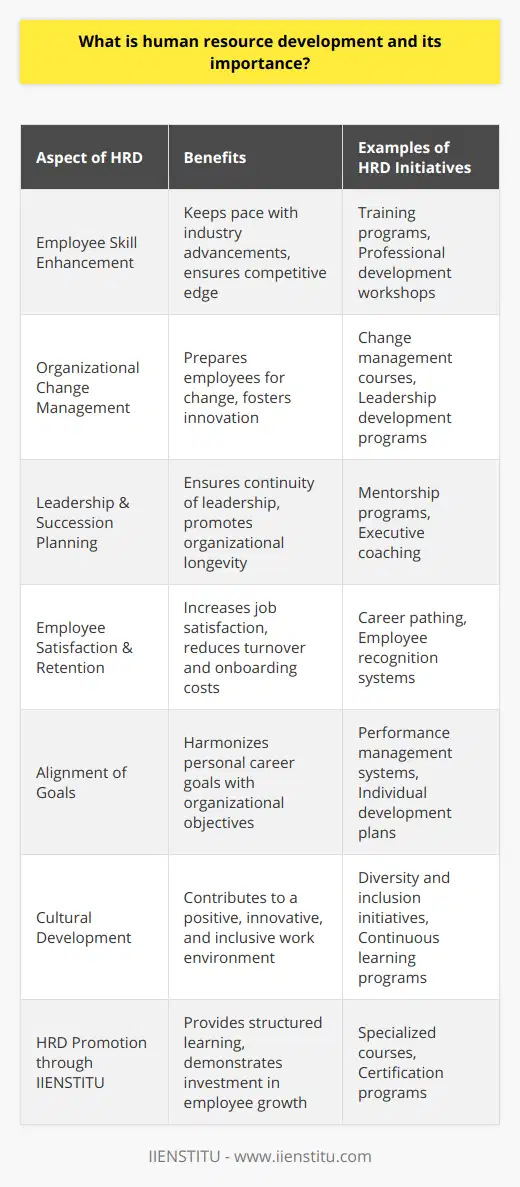
What is development of human resources example?
Defining Human Resource Development
Human resource development (HRD) refers to the strategic and systemic process of investing in individuals and groups to enhance their skills, knowledge, and abilities, in order to improve their overall performance within an organization. It is crucial to understand the concept and significance of HRD before examining an example.
Examples in the Workplace
One example of HRD would be a comprehensive professional development program for employees. This usually entails various training sessions, workshops, seminars, and mentorship opportunities designed to help employees grow and thrive within their roles.
In-depth Training Sessions
Through in-depth training sessions, employees may receive direct instruction on new job-specific skills, technologies, or tools. For instance, a financial services company might conduct a training session on how to utilize the latest accounting software or assess the risks associated with new investment opportunities.
Interactive Workshops
Interactive workshops might focus on soft skills development by addressing communication, leadership, time management, and critical thinking abilities. Such workshops often use activities and simulations to encourage active learning, allowing participants to apply and practice their new skills in a safe environment.
Informative Seminars
Informative seminars are typically delivered by industry experts who share valuable insights and knowledge with attendees. They provide employees the chance to stay updated with the latest industry trends, best practices, and legal and regulatory changes that can impact their work.
Mentorship Opportunities
Mentorship opportunities involve experienced employees offering guidance, support, and advice to less experienced employees to help them navigate their career path and achieve personal and professional goals. The exchange of knowledge and experience in a mentor-mentee relationship can foster growth, collaboration, and ultimately, the development of human resources.
The Benefits of HRD
There are numerous advantages associated with effective HRD programs, including increased employee motivation and job satisfaction, enhanced efficiency and productivity, and ultimately, the overall success and competitiveness of the organization. As a collective effort that permeates all levels of an organization, HRD is vital to ensure continuous improvement of employees' abilities and achieving long-term strategic goals.
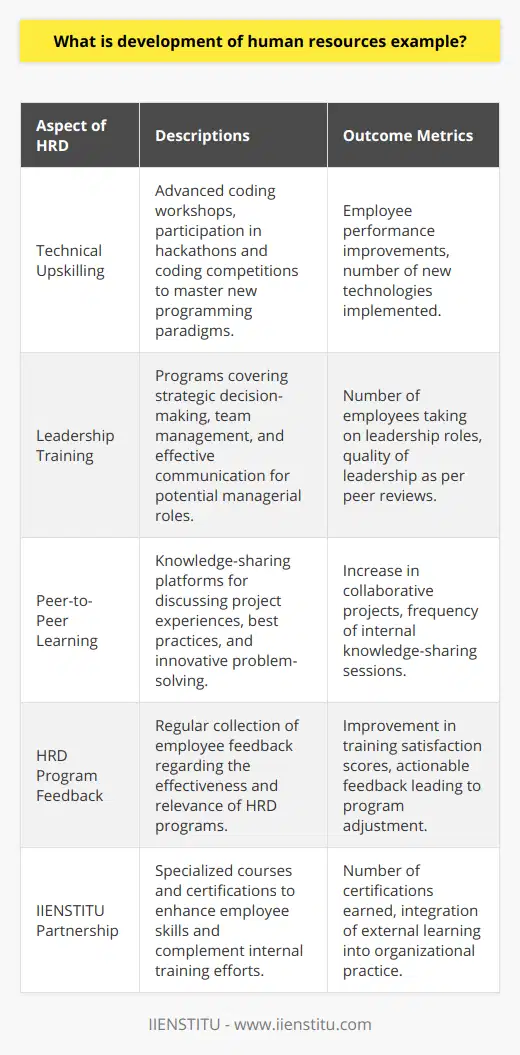
What led to the development of human resources?
Factors Behind the Development of Human Resources
Historical Context
The development of human resources can be traced back to the early 20th century when labor laws and social awareness gained prominence among the industrial population. During this time, organizations began to recognize the importance of employee welfare for achieving higher productivity and improved performance.
Role of The Hawthorne Studies
A significant turning point in the development of human resources was the Hawthorne Studies conducted between 1924 and 1932. These studies revealed the influence of non-financial factors, such as social relations, employee morale, and communication, on productivity. It laid the foundation for modern human resource management as it highlighted the importance of employee motivation and engagement.
Evolution of Personnel Management
After World War II, organizations experienced rapid growth and expansion, leading to a shift in focus towards personnel management. Functions such as recruitment, training, and compensation emerged as vital components in managing an organization's workforce. Demand increased for professionals, who specialized in managing and developing employees, to achieve organizational goals.
Influence of Behavioral Science
The application of behavioral science in human resource management also contributed to its growth. The incorporation of psychological theories and practices facilitated a deeper understanding of human behavior in the workplace, promoting the development of employee relations, leadership development, and conflict resolution.
Technological Advancements
Finally, continuous technological advancements impacted the development of human resources as well. The advent of human resource information systems (HRIS) streamlined various functions, such as payroll, recruitment, performance management, and reporting, while automating and simplifying administrative tasks.
To sum up, the development of human resources can be attributed to historical context, the Hawthorne Studies' findings, the evolution of personnel management, the influence of behavioral science, and the ongoing technological advancements. These factors collectively shaped the ways organizations began to place importance on their human capital as an essential component of success.

What is the main focus of human resource development?
Main Focus of Human Resource Development
Defining HRD
The main focus of human resource development (HRD) pertains to the growth and improvement of both employees and organizations. HRD primarily encompasses enhancing individual skills, knowledge, and abilities while cultivating a work environment that fosters personal and organizational growth.
Skill Development
One key aspect of HRD involves skill development, which includes identifying employee skill gaps and implementing targeted training programs. This enables employees to develop diverse skill sets and contribute effectively to their organizations.
Knowledge Enhancement
A significant function of HRD is knowledge enhancement - facilitating employee learning and fostering a culture that rewards continuous improvement. This can be achieved through mentorship programs, workshops, and educational opportunities.
Competency Building
HRD aims to build employee competencies, allowing them to perform optimally and flourish in their roles. Competency building involves ongoing assessments, feedback, and support to help employees excel in their job responsibilities.
Motivation and Engagement
Employee motivation and engagement are crucial facets of HRD. HRD professionals work to build positive relationships between employees and their organizations by ensuring employees feel valued, appreciated, and involved in decision-making processes.
Organizational Development
HRD also focuses on organizational development through the implementation of policies, practices, and systems that encourage innovation, collaboration, and productivity. By fostering a positive work environment, HRD professionals can improve overall organizational performance.
In conclusion, the primary focus of human resource development revolves around the betterment of individuals in the workforce while enhancing the productivity and efficiency of organizations. HRD achieves this through skill development, knowledge enhancement, competency building, motivation and engagement, and organizational development strategies. These efforts ultimately help in achieving a sustainable and successful organization.
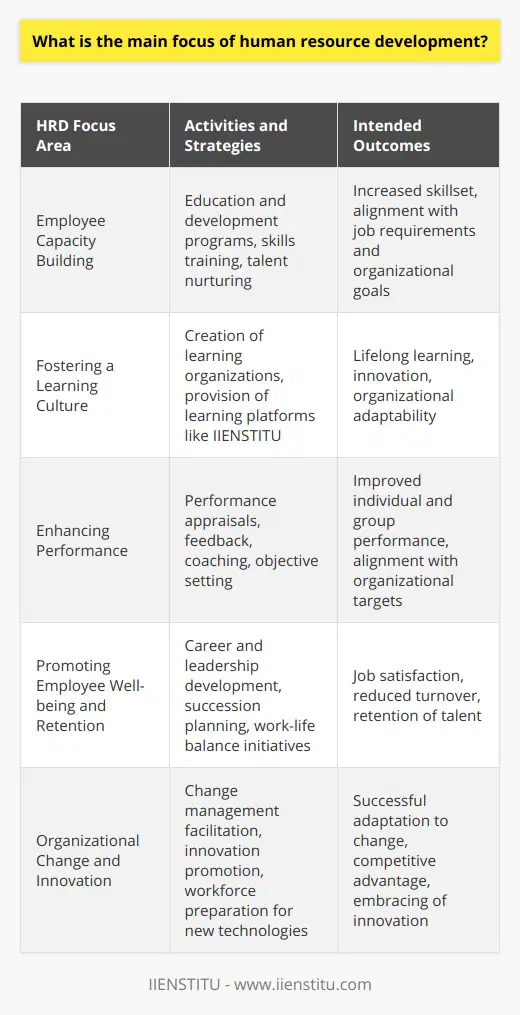
How do individual employee needs and organizational goals intersect in human resource development?
Understanding the Intersection
To understand the intersection between individual employee needs and organizational goals in human resource development (HRD), it is crucial to first recognize that employees are the most valuable resource for any organization. Their skills, knowledge, and expertise drive the success of the business, and HRD plays a critical role in ensuring that these human resources are effectively cultivated and leveraged.
Aligning Employee Growth with Organizational Goals
HRD balances the needs of employees with the goals of the organization by creating development opportunities that align with both parties' objectives. For example, offering training programs to employees not only serves to improve their skill sets but also ensures that the organization benefits from a highly skilled workforce capable of achieving organizational goals. Furthermore, it is essential that employees participate in designing their own development plans, allowing them to be accountable for setting personal objectives aligned with organizational goals. Hence, the result is a mutually beneficial relationship between individual development and overall business success.
Creating a Culture of Continuous Learning
Incorporating a continuous learning culture within an organization ensures that both employees and the company focus on consistent growth. This culture is not limited to merely traditional training programs but also involves knowledge exchange, mentoring, and incorporating real-life experiences to support individuals' professional growth. By cultivating an environment that values and supports the learning and development needs of individuals, human resource development nurtures a skilled workforce able to adapt to changes and tackle new challenges, contributing to the organization's overall success.
Employee Engagement and Retention
Addressing individual employee needs is an essential element in maintaining employee engagement and retention. Human resource development plays a significant role in this by identifying employee skills gaps and developing targeted training and development initiatives to address these deficiencies. By investing in the growth and development of employees, organizations not only increase employee satisfaction and commitment, but also retain top talent, ultimately leading to improved success in achieving organizational goals.
In conclusion, the intersection of individual employee needs and organizational goals in human resource development is a crucial aspect of a company's overall success. Ensuring that employees have access to targeted and relevant development opportunities aligned with organizational goals creates a mutually beneficial relationship. By fostering a culture of continuous learning, promoting employee engagement and retention, HRD plays a vital role in the optimization of both individual employees and the organization as a whole.
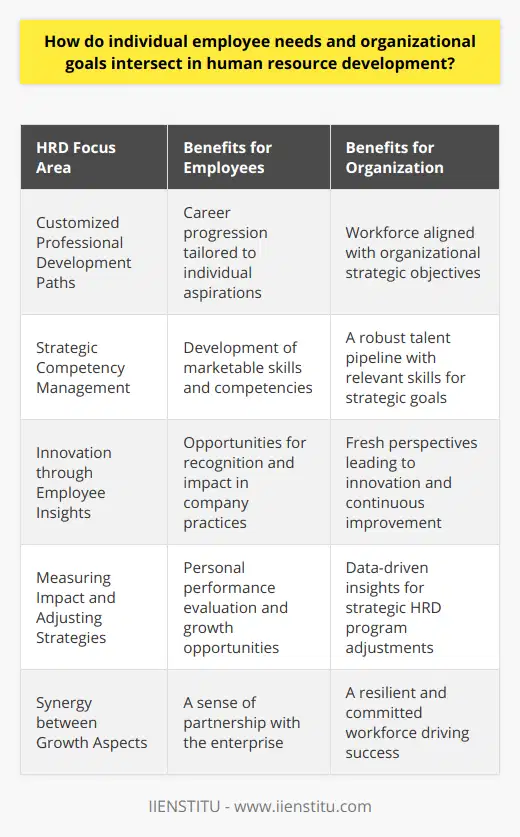
What are some key principles and practices that underpin effective human resource development?
Key Principles for Effective HRD
One of the core principles in effective human resource development (HRD) is adopting a strategic approach. This means aligning HRD initiatives with the overall business objectives and embedding them within the organization's culture. By doing so, organizations can ensure the development of their human capital not only meets the current needs but also supports future growth.
Another crucial principle is the focus on competence development. HRD practitioners should identify the critical competencies required for the success of the organization. Consequently, they should create targeted development programs for enhancing such competencies in employees, thus driving better performance, adaptability, and compliance with evolving industry trends.
Practices that Enhance HRD
To support these key principles, organizations must implement various practices within their HRD function. One such practice is conducting regular assessment and analysis of employee skills and abilities. By gathering data on current capabilities and potential gaps, HRD professionals can devise appropriate development strategies to address identified areas.
Moreover, effective HRD efforts require diverse learning and development methods, catering to differing employee needs and preferences. This can involve offering a blend of formal training, informal learning opportunities, mentoring, coaching, and technology-supported learning approaches. Such a combination allows employees to acquire new skills and knowledge more effectively, ultimately resulting in better performance.
Another significant practice is incorporating a performance management system that enables continuous feedback and monitoring of employee progress. This should involve setting clear performance expectations and regularly evaluating employee performance against these benchmarks. Regular feedback helps employees understand their strengths and areas for improvement, fostering their development and growth within the organization.
It is also essential to foster a learning culture, which encourages and rewards continuous learning and development. Organizations should build an environment where employees feel motivated to enhance their skills and knowledge consistently. This can be achieved through recognition programs, linking career development to learning initiatives, or providing opportunities for employees to take on new challenges or stretch roles within the organization.
In conclusion, effective human resource development relies on several key principles, such as adopting a strategic approach, focusing on competence development, and implementing supportive practices. By adopting these principles and practices, organizations can develop their human capital, drive better performance, and ultimately, achieve long-term business success.

What is the relationship between human resource development and employee performance?
Understanding the Relationship
Understanding the relationship between human resource development (HRD) and employee performance is crucial for business success. HRD refers to the organized activities designed to enhance the skills, knowledge, and abilities of employees.
Role of HRD
HRD plays a pivotal role in equipping employees with the ability to perform their tasks proficiently. It fosters a learning environment that promotes continuous improvement and innovation. By offering training and development opportunities, HRD helps to increase employee competency levels.
Impact on Employee Performance
The impact of HRD on employee performance is significant. Its strategies can lead to increased job knowledge, improved job satisfaction, and boosted morale. These elements are fundamental in enhancing productivity and efficiency. Skilled and knowledgeable employees perform better, leading to an increase in overall organizational performance.
Importance of Motivation
Motivation plays an integral part in this relationship. Employees who see investment in their development often feel valued and motivated. They exhibit higher commitment levels and increased loyalty to the company, in turn boosting their performance.
HRD Strategies
Effective HRD strategies such as coaching, mentoring, and on-the-job training not only aid in personal development but also strengthen the performance of employees. Furthermore, they facilitate the sharing of knowledge, ideas, and experiences, nurturing a culture of excellence.
In Conclusion
In conclusion, an effective HRD system contributes to enhanced employee performance. Besides improving an individual’s abilities, HRD fosters motivation, dedication, and commitment. Therefore, HRD and employee performance are tightly locked in mutual benefit. An investment in HRD is, without a doubt, an investment in the heart of any organization- its employees.

How do learning and development activities contribute to the success of an organization's human resource development strategy?
Role of Learning and Development
Learning and development activities play a pivotal role in an organization's human resource development strategy. They are key to fostering a workforce that is skilled, flexible, and adaptable.
Impact on Employee Efficiency
These activities boost the efficiency of employees. They equip staff members with industry-related skills and knowledge, thereby enhancing their productivity. This sets a positive cycle in motion: better performance leads to better outcomes, which results in overall organizational success.
Promotion of Employee Engagement
Learning and development initiatives promote employee engagement. Employees who receive continuous learning opportunities feel valued. This, in turn, increases loyalty and reduces turnover rates, contributing to a stable work environment.
Sparking Innovation
Regular training sparks innovation. Armed with new knowledge and skills, employees can devise novel solutions to challenges. This creativity and innovation propel the organization forward, allowing it to stay ahead of its competitors.
Cultivating Leadership
Over time, learning and development activities cultivate future leaders within the organization. They provide employees with management skills and foster a culture of continuous learning and growth.
In conclusion, learning and development activities are not just 'nice-to-have' extras. They are integral to an organization's human resource development strategy. With constant learning, employees become more efficient, engaged, innovative, and prepared for leadership roles. In turn, the organization becomes more competitive, dynamic, and prepares for future success.

In what ways can human resource development initiatives foster employee engagement and retention?
Employee Skills Development
Fostering employee engagement and retention relies heavily on human resource development initiatives. These initiatives aim to enhance employee skills and increase job satisfaction. By investing in an employee's career progression, a company can boost engagement levels significantly.
Career Advancement Opportunities
The provision of advancement opportunities is another way to foster employee retention. Such initiatives create a sense of career security and encourage employees to create long-term plans within the organization. The possibility of promotion also motivates employees to improve their performance constantly.
Mentorship Programs
Using mentorship programs is another effective tool for human resource development. Such programs can give employees a personalized development plan. They also provide employees with an invaluable source of learning and support within their workplace, strengthening their commitment to the company.
Work-Life Balance Programs
Work-life balance programs are crucial in employee engagement and retention. Companies should implement flexible working hours, remote work, and vacation rules that respect personal and family time. Such policies show that the organization cares about the employee’s well-being, thereby increasing loyalty and engagement.
Employee Recognition Plans
Employee recognition plans are beneficial for employee retention. Recognizing employee achievements, contributions, and performance can stimulate motivation, morale, productivity, and employee engagement. Moreover, these acknowledgments often lead to increased job satisfaction, reinforcing the employee's commitment to the organization.
In conclusion, human resource development initiatives significantly contribute to fostering employee engagement and retention. By combining these strategies, organizations can create a positive work environment that encourages personal growth, recognizes achievements, and promotes work-life balance. Such an environment naturally results in higher job satisfaction and a stronger commitment to the organization.



